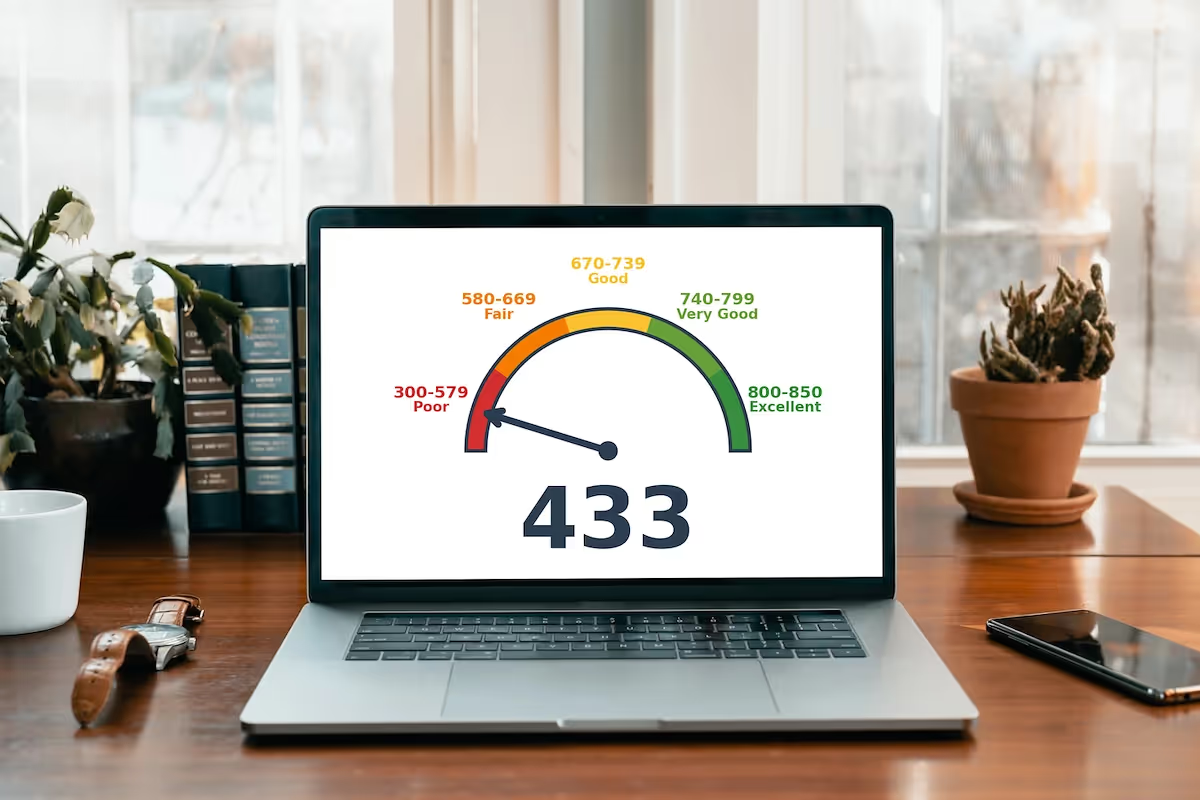
Kudos has partnered with CardRatings and Red Ventures for our coverage of credit card products. Kudos, CardRatings, and Red Ventures may receive a commission from card issuers. Kudos may receive commission from card issuers. Some of the card offers that appear on Kudos are from advertisers and may impact how and where card products appear on the site. Kudos tries to include as many card companies and offers as we are aware of, including offers from issuers that don't pay us, but we may not cover all card companies or all available card offers. You don't have to use our links, but we're grateful when you do!
433 Credit score: What You Need to Know in 2025
July 1, 2025


TL;DR
A 433 credit score offers a significant opportunity for improvement and is a starting point for building a stronger financial foundation. This score falls into the 'Poor' range on the FICO scale, providing a clear roadmap for which areas to focus on to boost your creditworthiness.
What Does a 433 Credit Score Mean?
A 433 credit score is considered poor on the FICO Score 8 model, which ranges from 300 to 850. Scores below 580 fall into this category, signaling to lenders that you are a high-risk borrower. This number is a snapshot of your credit history, reflecting how you've managed past debt obligations. Lenders use this score as a primary factor when deciding whether to approve you for new credit.
Financially, a 433 score creates significant obstacles. You will likely face denials for mortgages, auto loans, and new credit cards. If you are approved, it will probably be with very high interest rates and unfavorable terms, making borrowing much more expensive. While this score presents immediate challenges, it is not a permanent financial sentence and can be improved over time.
Who Has a 433 Credit Score?
While age isn't a direct factor in calculating your credit score, there is a clear correlation showing that scores tend to increase over time. According to 2023 data, the average FICO score by generation breaks down as follows:
- Generation Z (ages 18-26): 680
- Millennials (ages 27-42): 690
- Generation X (ages 43-58): 709
- Baby Boomers (ages 59-77): 745
- Silent Generation (ages 78+): 760
Credit Cards With a 433 Credit Score
A 433 credit score falls into the "very poor" range, which signals significant risk to potential lenders. Consequently, you'll likely face challenges when applying for traditional unsecured credit cards, as most issuers will be hesitant to extend credit. Your options will probably be limited to products designed for building credit, such as secured credit cards, which require a cash deposit as collateral.
Kudos offers tools like the Explore Tool, which uses a quiz about your financial preferences to provide personalized credit card recommendations from its database of nearly 3,000 cards. Features like Credit Score Insights help you understand the potential impact of new cards on your credit, ensuring you find a match that helps you build credit responsibly.
Auto Loans and a 433 Credit Score
A 433 credit score places you in the "deep subprime" category, which can make securing an auto loan challenging. Lenders view this score as high-risk, often resulting in much higher interest rates or potential denial of your application.
According to a Q2 2025 market report, average auto loan rates break down as follows:
- Super-prime (781-850): 5.25% for new cars, 7.13% for used cars
- Prime (661-780): 6.87% for new cars, 9.36% for used cars
- Non-prime (601-660): 9.83% for new cars, 13.92% for used cars
- Subprime (501-600): 13.18% for new cars, 18.86% for used cars
- Deep subprime (300-500): 15.77% for new cars, 21.55% for used cars
Mortgages at a 433 Credit Score
With a 433 credit score, qualifying for a mortgage is extremely difficult. Most lenders have minimum score requirements you won't meet. For instance, FHA loans, one of the most accessible options, typically require a score of at least 500 with a 10% down payment. While some specialty or subprime lenders might consider sub-580 scores, approval is rare and not guaranteed.
If you do find a lender, expect significantly higher interest rates and fees. Lenders will also likely cap the loan amount and subject your finances to a rigorous manual underwriting process. These stricter terms are in place to offset the high risk associated with a low credit score, making any potential loan much more expensive over its lifetime.
What's in a Credit Score?
Understanding your credit score can feel like trying to solve a complex puzzle, as it's a blend of several key financial habits. The most common factors that determine your score include:
- Your payment history tracks whether you have paid past credit accounts on time.
- Credit utilization is the percentage of your available credit that you are currently using.
- The length of your credit history considers the age of your oldest account and the average age of all your accounts.
- Credit mix refers to the variety of credit products you have, such as credit cards, retail accounts, and loans.
- New credit inquiries and recently opened accounts can also temporarily impact your score.
How to Improve Your 433 Credit Score
While a 433 credit score falls into the poor range, it is entirely possible to improve it with a dedicated strategy and consistent effort. By taking the right steps, you can begin to see meaningful changes within a few months.
- Make on-time payments. Your payment history is the most significant factor in your score, so setting up automatic payments can prevent missed due dates. Consistently paying your bills on time is the most critical step to rebuilding your credit history.
- Monitor your credit reports. Regularly reviewing your credit reports helps you find and dispute inaccuracies or fraudulent activity that could be dragging your score down. Correcting these errors can provide a direct and sometimes immediate boost to your score.
- Lower your credit utilization ratio. This ratio compares your credit card balances to your total credit limits, and keeping it below 30% is key. Paying down your balances shows lenders you can manage credit responsibly, which is vital when your score is low.
- Consider a secured credit card. For those with damaged credit, a secured card is an accessible tool for rebuilding a positive payment history. Because these cards report to the major credit bureaus, responsible use can directly help improve your score over time.
The free Kudos browser extension can help you manage your cards and optimize rewards as you work to improve your credit score.
Unlock your extra benefits when you become a Kudos member

Turn your online shopping into even more rewards

Join over 400,000 members simplifying their finances

Editorial Disclosure: Opinions expressed here are those of Kudos alone, not those of any bank, credit card issuer, hotel, airline, or other entity. This content has not been reviewed, approved or otherwise endorsed by any of the entities included within the post.



































.webp)



.webp)

.webp)


